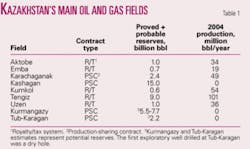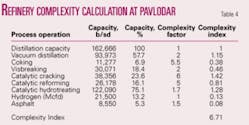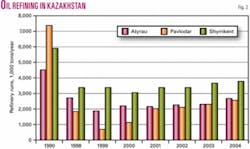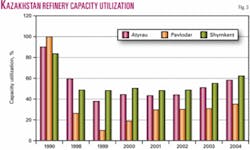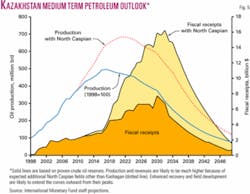Mark J. Kaiser, Allan G. Pulsipher - Louisiana State University, Baton Rouge
The government of Kazakhstan recognizes the need to develop policies and reforms that support sustainable growth and has sought to diversify the transport infrastructure of the country and the connectivity of the region.
In Part 2 of this three-part article, we review the contracts used in Kazakhstan for exploration and production, summarize a medium-term outlook for the country, and describe the current status of the pipeline infrastructure. Highlights of Kazakhstan’s refineries and refined product consumption are also presented.
Contract types
Many styles of contracts govern the E&P arrangements in Kazakhstan.
These arrangements have evolved over the past decade in response to political, economic, technical, and geologic conditions. Today, essentially three types of E&P contracts are in use:
- Concessionary (royalty/tax).
- Contractual (production sharing contracts).
- Participation agreements.
Each arrangement provides for different levels of control to the international oil company (IOC), for different compensation arrangements, and for different levels of Kazmunaigaz (KMG) involvement.13 21 The terms of the early blocks awarded after Kazakhstan’s independence were designed to encourage E&P activity. Recently, model contract terms have been introduced to establish a common basis for future negotiation.
Royalty-tax systems allow the title to hydrocarbons to transfer to the IOC, while under a contractual system the government retains title to the mineral resources and maintains closer control of the management of the operation. Participation agreements create a joint venture between the Republic of Kazakhstan and the IOC through KMG as partner.
Under a royalty-tax system, the contract holder secures exclusive exploration rights for a specified duration, and development and production rights for each commercial discovery, subject to the payment of royalty and taxes. The IOC bears the sole cost and risk of E&P activity.
Early concessionary agreements consisted of a royalty and tax, but as Kazakhstan gained experience and bargaining power, royalties increased and various levels of taxation have been added. Kazakhstan’s new Model 1 contracts employ numerous fiscal devices and sophisticated formulas to capture rent (see sidebar, p 34).
Under joint venture agreements, the Kazakh government and foreign partners manage the operations under a joint equity financing structure regulated by a joint operating agreement, with operating cost financed by a system of monthly cash calls. The IOC will typically carry the government through the exploration phase, while the IOC and KMG share the risk and expense of production.
Under a PSC, the ownership of the resource remains with the state, and the IOC is contracted to explore and develop the resource in return for a share of the production. The IOC bears the sole cost and risk of E&P activity and is reimbursed for the cost along with a share of production that may result.
An agreed share of net revenues, referred to as cost oil, is made available to the contractor for recovery of exploration, development, and operating costs. The remaining hydrocarbon revenue, called profit oil, is split according to a negotiated formula.
Production by contract type
Since Kazakhstan established its independence in 1991, dozens of agreements have been signed as joint ventures under a royalty/tax arrangement and PSCs (Table 1).
The terms of the early blocks were designed to encourage E&P activity. Royalty/tax contracts govern 60-70% of Kazakh production, including Tengiz and most older, onshore fields. Karachaganak, Kashagan, and the Caspian Sea are governed under a PSC framework. When Kashagan and other offshore production comes on after 2008, the percentage of PSC production will increase.
Refinery configuration
Kazakhstan has refineries at Atyrau, Shymkent, and Pavlodar (Fig. 1).
In Soviet times, the refineries were part of a large interconnected system that served the interest of Russia, refining large volumes of fuel oil, low-quality diesel, and low-octane gasoline primarily for export to Russia (Atyrau and Pavlodar) and Uzbekistan (Shymkent).
Pavlodar and Shymkent depended on West Siberian oil, while Atyrau was originally designed to process oil from Baku and was later converted to process crude from Tengiz and Mangistau oblast fields.
null
The refineries have a total capacity estimated at 19.5 million tons/year, or 427,093 b/cd (Tables 2 and 3). Atyrau and Shymkent are basic operations with complexity factors of 2.8 and 2.6, respectively, and Pavlodar has the most secondary conversion capacity in the country at a composite index of 6.7 (Table 4).
All three refineries have a configuration significantly below the world average refinery complexity of 7.7. Pavlodar and Shymkent are owned by Mangistau and CNPC. The government controls Atyrau.
After 1991, utilization levels declined significantly and remain at depressed levels (Figs. 2 and 3). The refineries equipment and processes are outdated and inefficient, encumbered with disproportionate tax, payroll, and social burdens, and often incompetent or corrupt management.
The refineries have been sold multiple times under questionable circumstances and none has received the pledged investments.12 Several other factors have also contributed to the decline in production: the dependence on specific suppliers, the breakdown of customer relations, the declining domestic market, and government intervention.
Downsizing refineries to bring the distillation capacity in closer balance with the secondary processing capacity would likely increase efficiency and result in a higher degree of conversion. Modernizing older units through reconstruction of existing units will also improve utilization, but thus far, owners have run the refineries as cash flow machines without the necessary capital investments necessary to upgrade performance and-or sustain profitability.
The challenge for Kazakhstan refineries is to identify the key economic and geopolitical factors that will guide the future of refining and prepare for these changes. A realistic model for economically sustainable refining should be based on process economics, transport costs, potential for reconstruction, and social factors for each region and refinery.
Products consumption
The consumption pattern of petroleum products varies between countries and regions reflecting the use of oil as a transportation fuel, either as gasoline or diesel, or as a fuel oil in residential consumption or industry.
Gasoline, diesel, and fuel oil are the primary refined products consumed in Kazakhstan (Fig. 4, Tables 5-7). The totals in Tables 5-7 may not be in agreement due to inventories, losses, and other consumption.
null
null
Parts of the official statistics also appear ambiguous and should be interpreted with caution.
Both the import and export of gasoline have increased since 2000, with imports exceeding exports on an absolute basis. In 2004, 34% of gasoline consumption was imported and 16% of production exported.
Diesel oil production has increased nearly 50% since 2000, with exports exceeding imports and comprising roughly 32% of current production; 20% of diesel consumption is imported. Fuel oil trends are similar to diesel, with fuel oil production increasing about 30% since 2000.
Exports exceed imports by a factor of four and comprise nearly 30% of current production. Less than 10% of fuel oil consumption was imported.
Medium-term outlook
Over the next 15 years, Kazakhstan can reasonably expect crude oil and liquid production to increase more than threefold to 3.0-3.5 million b/d, according to an International Monetary Fund study.22
Production of natural gas has recently averaged around 14 bcm/year, and the government development plan projects a quadrupling of gas production to 60 bcm by 2010.23
At 3.0-3.5 million b/d of oil production, Kazakhstan is expected to be one of the world’s top 10 producers, behind the gulf states and Russia but on par with North Sea production at its height. Kazakhstan might even become one of the world’s top five producers.
Fiscal revenues generated from production are expected to rise to $16 billion/year (Fig. 5). The actual level realized, however, depends upon numerous uncontrollable and uncertain factors, including the level of production, the impact of legislative changes, the stability of contract arrangements, foreign direct investment, global oil price, etc.
null
Pipeline infrastructure
The oil pipeline system in Kazakhstan was constructed as part of an interconnected regional network and is currently composed of two disjointed subsystems that serve the western and eastern part of the country.
Oil fields in West Kazakhstan deliver crude to refineries in Russia via the Atyrau-Samara pipeline; refineries in Shymkent and Pavlodar use West Siberian crude oil shipped via the Omsk-Pavlodar-Shymkent-Chardzhou pipeline.
At present, Kazakhstan has three major export pipelines: Tengiz-Novorossiisk (Caspian Pipeline Consortium), Atyrau-Samara, and Kenkiyak-Orsk with a total export capacity (including railways) estimated at 1.5 million b/d. The CPC pipeline is Kazakhstan’s principal export route to world oil markets (Fig. 6).
An oil network to link western Kazakhstan to western China went into service this year. The first stage of development, the Atasu-Alashankou link, is to reach full operation in 2006 at a capacity of 10 million tons/year.
In the first half of 2005, Kazakhstan exported 1.1 million b/d of oil to world markets via the Black Sea, to Russia via pipeline and rail, through swaps with Iran, and by rail exports to China. The majority of Kazakh oil is exported through Russian territory via the Atryau-Samara and CPC pipeline.
The Atyrau-Samara pipeline has recently been upgraded through pumping and heating stations additions to increase capacity to 30 million metric tons/year. Kazakhstan also signed an agreement with Russia guaranteeing transport quotas for the next 15 years. The absolute volume of oil transported through the Atyrau-Samara route is expected to grow in the future, but the relative significance of the link is likely to diminish as CPC realizes full capacity.20
Kazakhstan also exports oil by tanker to the ports of the Caspian littoral states and by rail. The government is negotiating for export capacity on the Baku-Tbilisi-Ceyhan (BTC) pipeline. Kashagan development consortium members are in talks to export around 20 million metric tons/year of oil from Kashagan via the Caspian Sea to Baku, Azerbaijan, for transport through BTC.
A transit route through Turkmenistan-Iran is the most favorable route for transportation of Kazakh oil to the Persian Gulf, but certain political issues must be resolved since the Iran-Libya Sanctions Act prohibits US companies from conducting business with Iran and imposes sanctions on non-US companies investing in the oil-gas sector.
Caspian Pipeline Consortium
The CPC pipeline links supergiant Tengiz oil field with the Novorossiisk terminal on the Russian Black Sea coast.
The pipeline started operating in March 2001, and its capacity is 28 million metric tons/year. For the past 18 months, CPC has been transporting over 2 million metric tons a month of Kazakh oil-around 530,000 b/d-representing nearly half of the total current oil exports and virtually all of the light oil and condensate production in Kazakhstan.
The CPC pipeline is the first and only privately operated pipeline to be constructed in the former Soviet Union.
CPC shareholder structure is complex and includes the governments of Russia 24%, Kazakhstan 19%, and Oman 7%. Corporate shareholders are Chevron Caspian Pipeline Consortium Co. 15%, LukArco BV 12.5%, Rosneft-Shell Caspian Ventures 7.5%, Mobil Caspian Pipeline Co. 7.5%, Agip International NV 2%, BG Overseas Holding Ltd. 2%, Kazakhstan Pipeline Ventures LLC 1.75%, and Oryx Caspian Pipeline LLC 1.75%.
CPC owns and operates the pipeline. Corporate governance and management reflects the complexity of the entity.
The corporate shareholders expect future demand for capacity in CPC to be oversubscribed and have initiated the engineering design on a $1.6 billion build out program to achieve CPC’s full capacity of 67 million tons a year, to be realized in stages-10 million tons capacity addition by 2007, another 10 million tons in 2008, and the final build out in 2009.
Expansion politics
In 2004, the Russian Federation set down seven conditions for agreeing to expansion of the CPC pipeline that were designed to address what the government saw as structural faults in the original CPC contract. The conditions fall into three categories:24
1. Financial performance.
• Reduce interest rates on the loans provided by the producing companies for the initial construction project, but not the interest rates on the debts owed to the government shareholders in CPC for the value of the assets transferred into the project.
• Increase the tariff by $2.50/ton to $30.83/ton in order to accelerate repayment of existing debt.
• Cancel the claim against the Russian and Kazakhstan government debt for the cost of making ready the assets transferred to the consortium.
• Make all existing debt equal in terms of repayment priority (presently, government debt has a lower priority).
2. Operating conditions.
• Producing companies need to underwrite their volume forecasts for expansion with send or pay guarantees.
• If necessary, revise the tariff in order to recoup any overruns in the capital cost of the expansion.
• Finance the project with externally sourced funds and subordinate existing debt to this new borrowing.
3. Governance.
• Fifty percent of the management of CPC will be provided by government shareholders.
• The next general director of CPC will be a nominee of the Russian Federation.
In October 2005, the six international oil and gas companies in CPC completed a memorandum of understanding (MOU) satisfying the demands of the Russian government as well as the individual shareholders.24 In April 2006, Vladimir Razdukhov was elected general director of CPC, replacing Ian MacDonald. A final decision by Russia has not yet been announced.
Next: A discussion of Kazakh legislative and regulatory issues.
